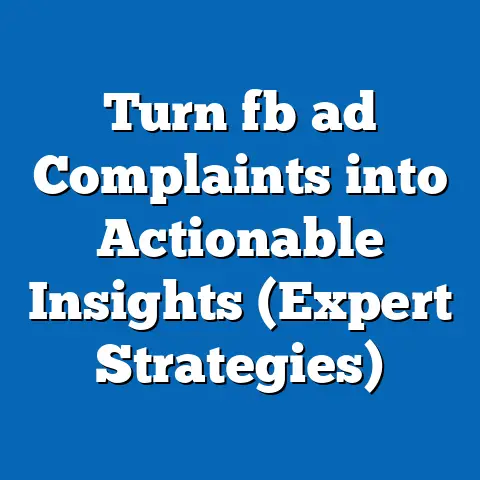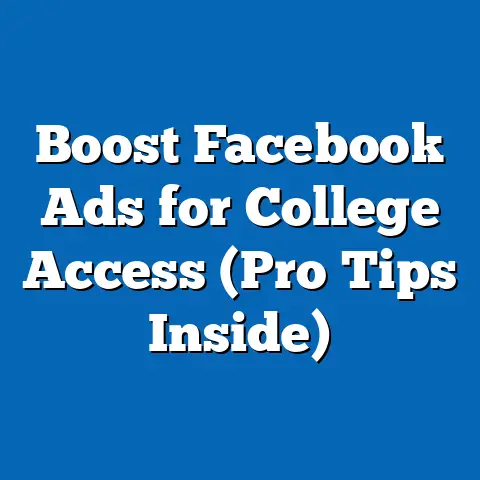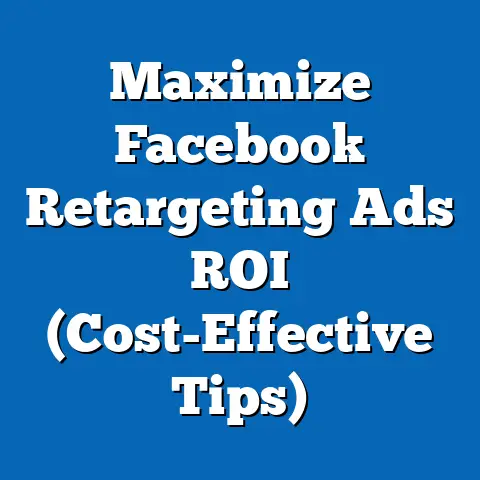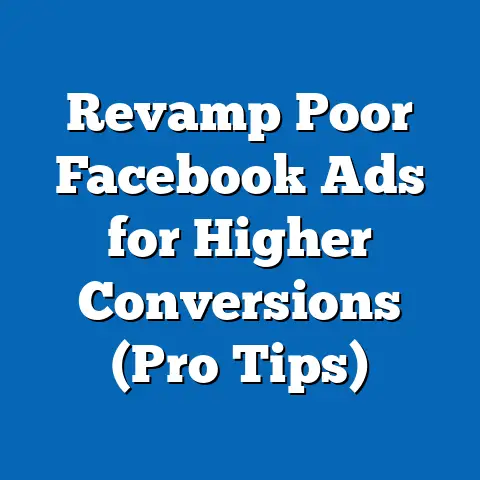Boost Ad Performance with Facebook Metrics (Data-Driven Mastery)
Have you ever felt like you’re throwing money into a black hole with your Facebook ads, unsure if you’re getting any real return? I know I have. Many businesses allocate significant budgets to Facebook advertising, hoping to reach a wider audience and drive sales. However, without a clear understanding of the metrics that truly matter, optimizing ad campaigns can feel like navigating in the dark. It’s like trying to bake a cake without a recipe – you might get lucky, but the odds are stacked against you.
That’s where data-driven decision-making comes in. By leveraging the wealth of information that Facebook provides, you can transform your advertising from a guessing game into a strategic, results-oriented process. This guide will walk you through the key Facebook ad metrics, explain why they’re important, and show you how to use them to boost your ad performance and achieve a better ROI. Get ready to illuminate your advertising path with the power of data!
Understanding Facebook Ad Metrics
The Facebook Ads Manager is a treasure trove of data, but it can also feel overwhelming. To start our journey towards data-driven mastery, let’s break down the core metrics you’ll encounter and what they actually mean.
Impressions and Reach: Visibility Matters
These two metrics are often confused, but understanding the difference is crucial for gauging your ad’s visibility.
- Impressions: This is the total number of times your ad was displayed, regardless of whether it was seen by the same person multiple times.
- Reach: This is the number of unique individuals who saw your ad.
Why they’re important: Impressions tell you how often your ad is being served, while reach tells you how many different people are seeing it. High impressions with low reach might indicate that the same people are seeing your ad repeatedly, which could lead to ad fatigue.
How to interpret them: If you’re aiming for brand awareness, a high reach is essential. If you’re retargeting a specific audience, higher impressions with a slightly lower reach might be acceptable.
My Experience: I once ran a campaign targeting a very niche audience. While my reach was relatively small, my impressions were high. Initially, I was concerned, but then I realized that this meant my target audience was seeing my ad multiple times, reinforcing my message and ultimately leading to a higher conversion rate.
Takeaway: Understand the difference between impressions and reach, and use them to evaluate your ad’s visibility and potential for impact.
Click-Through Rate (CTR): Gauging Engagement
CTR is a fundamental metric that measures how often people who see your ad actually click on it.
- Definition: CTR is calculated as the number of clicks your ad receives divided by the number of impressions, expressed as a percentage.
Why it’s important: CTR is a direct indicator of how engaging and relevant your ad is to your target audience. A higher CTR suggests that your ad copy, visuals, and targeting are resonating with users.
How to interpret it: A low CTR could mean that your ad is not visually appealing, the copy is not compelling, or you’re targeting the wrong audience. A high CTR, on the other hand, indicates that your ad is capturing attention and driving engagement.
Example: Let’s say your ad has 1,000 impressions and 20 clicks. Your CTR would be (20 / 1,000) * 100 = 2%.
Industry Benchmark: According to recent data, the average CTR for Facebook ads across all industries is around 0.9%. However, this can vary significantly depending on your industry, audience, and ad objective.
Takeaway: Monitor your CTR closely and use it to identify areas for improvement in your ad creative and targeting.
Conversion Rate: Turning Clicks into Action
Conversion rate measures the percentage of people who click on your ad and then complete a desired action, such as making a purchase, filling out a form, or signing up for a newsletter.
- Definition: Conversion rate is calculated as the number of conversions divided by the number of clicks, expressed as a percentage.
Why it’s important: Conversion rate is a critical metric for evaluating the effectiveness of your ad campaign in achieving your business goals. It tells you how well your ad is converting clicks into valuable actions.
How to interpret it: A low conversion rate could indicate issues with your landing page, your offer, or the overall user experience after someone clicks on your ad. A high conversion rate suggests that your ad is effectively driving people to take the desired action.
Example: If your ad receives 100 clicks and results in 5 sales, your conversion rate would be (5 / 100) * 100 = 5%.
Relating to other metrics: A high CTR but low conversion rate suggests that while your ad is attracting attention, something is preventing people from completing the desired action.
Takeaway: Optimize your landing page and offer to improve your conversion rate and maximize the ROI of your ad campaigns.
Cost Per Click (CPC) and Cost Per Acquisition (CPA): Understanding Your Spending
These metrics are essential for understanding the cost-effectiveness of your Facebook ads.
- Cost Per Click (CPC): The amount you pay each time someone clicks on your ad.
- Cost Per Acquisition (CPA): The amount you pay for each desired action (e.g., purchase, lead generation) that results from your ad.
Why they’re important: These metrics help you understand how much you’re spending to acquire customers or achieve specific goals.
How to interpret them: A high CPC could indicate that your ad is not relevant to your target audience or that there’s high competition for your keywords. A high CPA could mean that your ad is not effectively driving conversions, or that your landing page needs optimization.
Example: If you spend $100 on an ad campaign and receive 50 clicks, your CPC would be $100 / 50 = $2. If those 50 clicks result in 2 sales, your CPA would be $100 / 2 = $50.
Relating to other metrics: Lowering your CPC can increase your ROI, while reducing your CPA can make your advertising more profitable.
Takeaway: Continuously monitor and optimize your CPC and CPA to ensure you’re getting the most out of your advertising budget.
The Importance of Tracking and Analyzing Data
Understanding individual metrics is only the first step. To truly master Facebook advertising, you need to track and analyze your data over time. This process provides invaluable insights that can significantly improve your campaign performance.
Identifying Trends: Seeing the Big Picture
Tracking your metrics over time allows you to identify trends and patterns that might not be immediately apparent.
- Definition: Trend identification involves analyzing historical data to spot recurring patterns or shifts in performance.
Why it’s important: Identifying trends allows you to make proactive adjustments to your campaigns, rather than reacting to problems after they’ve already impacted your results.
Example: You might notice that your CTR consistently drops on weekends. This could indicate that your target audience is less active on Facebook during those times, or that they’re more receptive to different types of content.
How to use it: Use this information to adjust your ad scheduling, creative, or targeting on weekends to improve your performance.
Personal Story: I remember working on a campaign for a local restaurant. Initially, we saw great engagement in the evenings. However, after a few weeks, the performance started to decline. By analyzing the data, we realized that people were seeing the same ad too many times. We refreshed the creative and saw an immediate improvement.
Takeaway: Regularly analyze your data to identify trends and make informed adjustments to your campaigns.
Audience Insights: Knowing Your Customer
Facebook provides detailed audience insights that can help you understand your target audience better.
- Definition: Audience insights provide information about the demographics, interests, behaviors, and preferences of your target audience.
Why it’s important: Understanding your audience allows you to create more targeted and relevant ad campaigns, which can lead to higher engagement and conversion rates.
Example: You might discover that your target audience is more likely to engage with video ads than image ads, or that they’re more responsive to certain types of messaging.
How to use it: Use this information to tailor your ad creative, copy, and targeting to resonate with your audience’s specific interests and preferences.
Tools: Facebook Audience Insights, Facebook Analytics
Takeaway: Leverage Facebook’s audience insights to gain a deeper understanding of your target audience and create more effective ad campaigns.
Performance Benchmarking: Setting Realistic Goals
Setting benchmarks based on industry standards or past performance is crucial for gauging the success of your campaigns.
- Definition: Performance benchmarking involves comparing your campaign metrics against industry averages or your own historical data to assess performance and identify areas for improvement.
Why it’s important: Benchmarking helps you set realistic goals, track your progress, and identify areas where you’re outperforming or underperforming.
Example: If your CTR is significantly lower than the industry average, it could indicate that your ad creative or targeting needs improvement.
How to use it: Use benchmarking to set realistic goals, track your progress, and identify areas for improvement in your campaigns.
Resources: Industry reports, Facebook Ads Manager
Takeaway: Set benchmarks based on industry standards or past performance to gauge the success of your campaigns and identify areas for improvement.
Advanced Metrics and Their Impact
Once you’ve mastered the basics, it’s time to delve into more advanced metrics that can provide deeper insights into your ad performance.
Engagement Rate: Measuring the Quality of Interactions
Engagement rate measures the level of interaction your ad receives, including likes, comments, shares, and saves.
- Definition: Engagement rate is calculated as the total number of engagements divided by the number of impressions, expressed as a percentage.
Why it’s important: Engagement rate provides insights into the quality of your ad content and how well it resonates with your audience.
How to interpret it: A high engagement rate indicates that your ad is capturing attention and sparking meaningful interactions, while a low engagement rate could suggest that your ad is not relevant or interesting to your target audience.
Example: If your ad receives 1,000 impressions and 50 engagements (likes, comments, shares), your engagement rate would be (50 / 1,000) * 100 = 5%.
Relating to other metrics: A high CTR but low engagement rate could indicate that your ad is attracting clicks, but the content is not compelling enough to drive further interaction.
Takeaway: Monitor your engagement rate and use it to refine your ad content and messaging to resonate with your audience.
Ad Frequency: Avoiding Ad Fatigue
Ad frequency measures the average number of times each person sees your ad.
- Definition: Ad frequency is calculated as the total number of impressions divided by the reach.
Why it’s important: High frequency can lead to ad fatigue, which can negatively impact your ad performance and brand perception.
How to interpret it: A high frequency could indicate that your target audience is seeing your ad too many times, which can lead to decreased engagement and increased annoyance.
Example: If your ad has 1,000 impressions and a reach of 200, your frequency would be 1,000 / 200 = 5. This means that, on average, each person is seeing your ad 5 times.
Industry Benchmark: The ideal frequency depends on your audience, industry, and ad objective. However, a general rule of thumb is to keep your frequency below 3.
Takeaway: Monitor your ad frequency and adjust your targeting or creative to avoid ad fatigue and maintain engagement.
Return on Ad Spend (ROAS): Measuring Financial Effectiveness
ROAS measures the revenue generated for every dollar spent on advertising.
- Definition: ROAS is calculated as the revenue generated from your ad campaign divided by the cost of the campaign.
Why it’s important: ROAS is a critical metric for measuring the financial effectiveness of your ad campaigns and determining whether your advertising is profitable.
How to interpret it: A high ROAS indicates that your ad campaign is generating significant revenue for every dollar spent, while a low ROAS could mean that your advertising is not profitable.
Example: If you spend $100 on an ad campaign and generate $500 in revenue, your ROAS would be $500 / $100 = 5. This means that for every dollar you spend, you’re generating $5 in revenue.
Industry Benchmark: The ideal ROAS depends on your industry and business goals. However, a general rule of thumb is to aim for a ROAS of at least 4.
Takeaway: Track your ROAS closely and use it to optimize your ad campaigns and maximize your return on investment.
Implementing a Data-Driven Strategy
Now that you understand the key metrics and their importance, let’s outline a step-by-step approach for implementing a data-driven strategy using Facebook metrics.
Setting Clear Objectives: Defining Your Goals
Before launching any ad campaign, it’s essential to define specific, measurable goals.
- Definition: Setting clear objectives involves defining what you want to achieve with your ad campaign, such as increasing brand awareness, driving website traffic, generating leads, or making sales.
Why it’s important: Clear objectives provide a roadmap for your campaign and help you track your progress and measure your success.
Example: Instead of saying “I want to increase sales,” set a specific goal like “I want to increase sales by 10% in the next month.”
Actionable Insight: Use the SMART framework (Specific, Measurable, Achievable, Relevant, Time-bound) to define your objectives.
Takeaway: Define specific, measurable goals before launching any ad campaign to provide a roadmap and track your progress.
Regular Monitoring and Adjustments: Staying Agile
Ongoing monitoring of metrics and adapting campaigns based on performance data is crucial for success.
- Definition: Regular monitoring and adjustments involve tracking your metrics on a daily or weekly basis and making changes to your campaigns based on the data you collect.
Why it’s important: This allows you to identify problems early on and make adjustments to improve your performance and achieve your goals.
Example: If you notice that your CTR is declining, you might need to refresh your ad creative or adjust your targeting.
Tools: Facebook Ads Manager, Google Analytics
Takeaway: Regularly monitor your metrics and adapt your campaigns based on the data you collect to improve your performance.
A/B Testing: Optimizing for Success
Effectively use A/B testing to refine ad copy, visuals, and audience targeting based on metric outcomes.
- Definition: A/B testing involves creating two or more versions of your ad and testing them against each other to see which one performs better.
Why it’s important: A/B testing allows you to identify the most effective ad copy, visuals, and targeting options, which can significantly improve your campaign performance.
Example: You might test two different headlines or two different images to see which one generates more clicks.
Actionable Insight: Use A/B testing to experiment with different elements of your ad and optimize for the best results.
Takeaway: Use A/B testing to refine your ad copy, visuals, and audience targeting based on metric outcomes.
Conclusion
Facebook metrics are your secret weapon for boosting ad performance and achieving a better ROI. By understanding the key metrics, tracking your data, and implementing a data-driven strategy, you can transform your advertising from a guessing game into a strategic, results-oriented process. I’ve seen firsthand how powerful this approach can be.
I encourage you to adopt a data-driven mindset and start analyzing your current campaigns with a focus on the metrics discussed in this article. By leveraging the right metrics to inform your decisions, you can unlock the full potential of Facebook advertising and achieve your business goals. So, dive in, analyze, optimize, and watch your ad performance soar!






